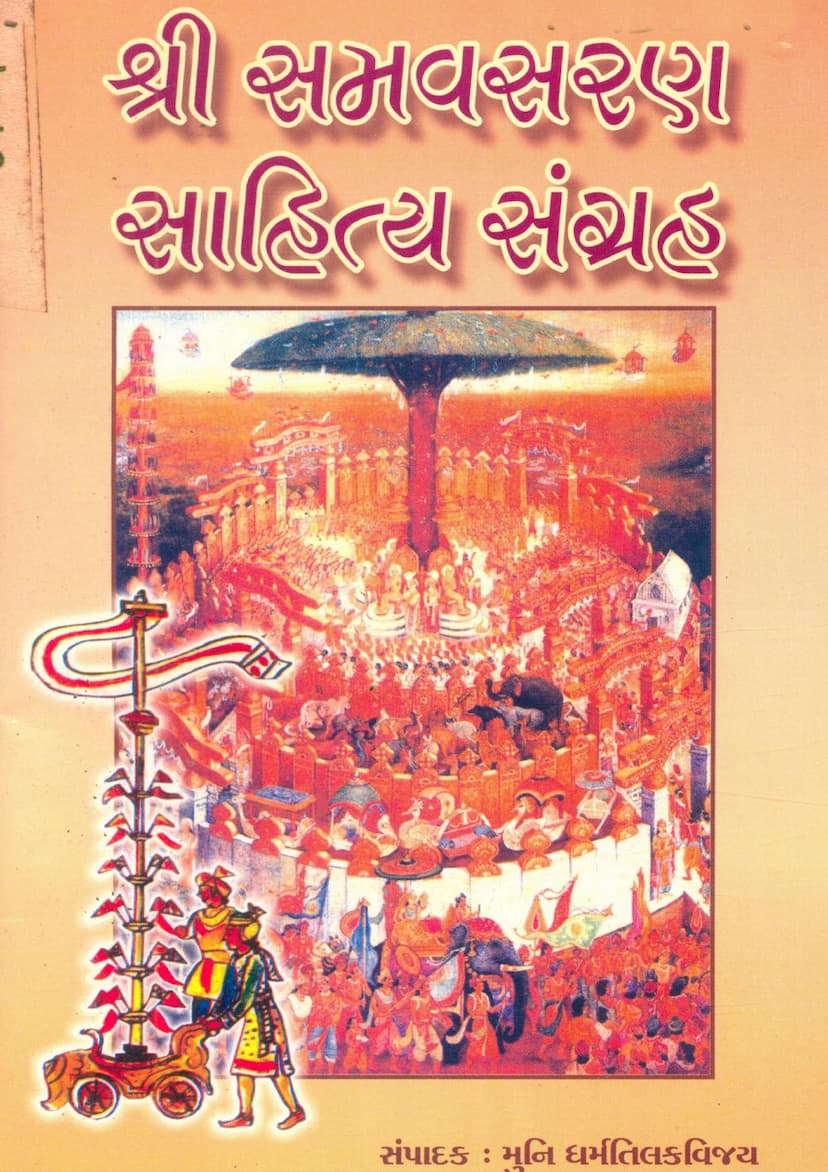Samavsaran Sahitya Sangraha
Added to library: September 2, 2025

Summary
This document is a collection of Jain texts related to the concept of the "Samavsaran," which refers to the divine assembly or pavilion established by a Tirthankar (a perfected human being who revives the Jain teachings).
Here's a breakdown of the key aspects and content:
Book Title: Samavsaran Sahitya Sangraha (Collection of Samavsaran Literature) Author: Muni Dharmtilakvijay Publisher: Smruti Mandir Prakashan
Core Theme: The primary focus of this compilation is to gather and present various literary works and information pertaining to the Samavsaran. The Samavsaran is a central concept in Jainism, representing the sacred space where a Tirthankar delivers sermons.
Key Content and Structure:
-
Introduction (Prastavana - Page 4-8):
- Explains the meaning of "Samavsaran" as defined in Jain scriptures, including literal and spiritual interpretations.
- Discusses the Samavsaran as a place where diverse beings (humans, animals, gods) gather.
- Draws parallels between the structure of the universe and the human body in relation to the Samavsaran.
- Details the architectural elements of the Samavsaran, such as the three ramparts (gadh), ramparts (kangra), Ashoka tree, and thrones.
- Highlights the miraculous aspects, like the 20,000 steps that are easily ascended due to the Tirthankar's presence.
- Emphasizes the Tirthankar's universal compassion that makes all beings feel comfortable and understood.
- Mentions the practice of Samavsaran meditation as a form of spiritual practice.
-
Editorial (Sampadakiya - Page 9-11):
- Discusses the process of attaining Tirthankarhood, starting from obtaining right faith (samyakdarshan) and accumulating Tirthankar-name karma.
- Explains the role of Indra and other deities in constructing the Samavsaran.
- Quotes verses from Acharya Hemachandrasuri about the Samavsaran's ability to quell enmity.
- Expresses gratitude to the patrons and guides involved in the publication.
-
Index (Anukramanika - Page 13):
- Lists the various Samavsaran stanzas (stavan/stotra), compositions related to Samavsaran construction (rachana kalpa), and appendices.
- Appendices include details on:
- The Samavsaran of the 24 Tirthankars.
- The duration of the Samavsaran.
- The phenomenon of flower showers during the Samavsaran.
- The twelve assemblies (parishada) present.
- The Chaitya trees of the 24 Tirthankars.
- Details on 363 types of philosophical viewpoints (which is an appendix about various philosophical schools debated in the Samavsaran).
- References to other Jain texts.
-
Illustrations and Descriptions (Pages 14-28):
- The pages contain verses, Sanskrit shlokas, and their Gujarati explanations that describe the Samavsaran's layout and features.
- These include:
- The four-faced sermon delivery.
- The three ramparts and their grandeur.
- The arrival of the Tirthankar.
- The divine attendants and their roles.
- The celestial chariot and the presence of eight auspicious symbols (Ashta Mahapratiharyas).
- Detailed measurements and construction of the Samavsaran, including its ramparts, gates, steps, and the central platform.
- Descriptions of the Ashoka tree, the divine assembly hall (Devachanda), and the four thrones.
- The presence of divine umbrellas, fly-whisks, and Dharma Chakras (wheels of righteousness).
- The seating arrangements of various assemblies (munis, gods, goddesses, humans).
- The cleansing and beautification by celestial beings.
- The specific roles of different deities in constructing and decorating the Samavsaran.
- The banners, toranas (arches), and incense offerings.
- The divine beings guarding the gates.
- The wells within the Samavsaran.
- The manner in which beings listen to the sermon, understanding it in their own language.
- The presence of reflections of the Tirthankar.
- The cessation of enmity among beings within the Samavsaran.
- The rituals performed, such as the offering of Boli (offerings).
-
Appendices (Parishishta - Pages 48-53):
- Provide specific details and references for deeper study.
- Appendix 1: States the different sizes (in yojanas) of Samavsarans associated with the 24 Tirthankaras.
- Appendix 2: Details the lifespan of the Samavsaran constructed by different celestial beings.
- Appendix 3: Discusses the nature of flower showers during the Samavsaran, addressing whether they are sentient or non-sentient.
- Appendix 4: Illustrates the arrangement of the twelve assemblies and their positions.
- Appendix 5: Lists the Chaitya trees of the 24 Tirthankaras along with their symbolic meanings and dimensions.
- Appendix 6: Explains the philosophical implications of the number 363, representing various schools of thought that were debated or addressed in the Samavsaran.
- Appendix 7: Provides a bibliography of texts that discuss the Samavsaran.
-
Biographical Information (Pages 54-59):
- Includes information about Acharya Shri Dharmaghoshasuri, who is credited with composing the Samavsaran Stava included in the book. It details his lineage, education, miracles, and literary contributions. This section provides historical and spiritual context for the text.
Overall Purpose:
The "Samavsaran Sahitya Sangraha" serves as a comprehensive resource for those interested in understanding the Samavsaran in Jainism. It aims to consolidate various aspects of this divine event, from its philosophical and architectural descriptions to its scriptural references and the spiritual significance attributed to it. The book is a scholarly compilation, drawing from multiple ancient Jain texts.